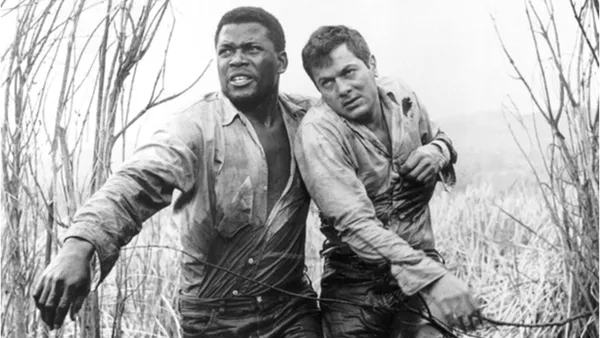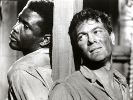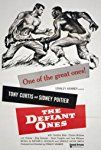Eye For Film >> Movies >> The Defiant Ones (1956) Film Review
The Defiant Ones
Reviewed by: Jennie Kermode

1958: the EEC and IMCO were founded; several former French colonies gained autonomy; women took their seats in the House of Lords, and air travel finally emerged as the predominant way of travelling overseas. The world at large was developing fast. In the southern US, however, it was still shocking to imagine that a black man and a white men might be friends. So much so that they made a movie about it.
That movie is The Defiant Ones. The only way it could set up its premise - two men of different races being handcuffed together - was to have a prison warden treat it as a joke. There's no friendship between the protagonists to begin with, and when they make their escape from a prison van following a crash, each is only interested in survival - but they each realise that killing the other would mean having to carry or drag his body as they try to make their way across country, dodging pursuit. Agreeing to an uneasy truce, they find themselves cooperating in a manner reminiscent of the chain gangs from which they have fled, though Joker (Tony Curtis) has no patience for the traditional singing that Noah (Sidney Poitier) is fond of.

With two of the era's most bankable stars, the film found it easy to pull in audiences despite what, for many viewers, was challenging subject matter, and the story was designed to encourage them to rethink their assumptions as the characters did. The widespread assumption that this was successful is testament to the greater spending power of white audiences and predominance of white critics, because it depends on an unquestioned assumption that each of our heroes is making the same journey. Noah's gradually thawing distrust of Joker goes some way to maintaining this illusion, but black audiences could not easily forget that he - initially imprisoned for rising to a white man's racist jibes - has far more to lose than his companion. When, towards the end, Joker makes a sacrifice for his friend, it is a small one compared to the one Noah will make in return. Joker is being asked to accept Noah's humanity; Noah is being asked, by way of accepting Joker, to accept the disparity in their social status.
Despite this imbalance, the film works well enough as an adventure story, and both the principal actors are on great form despite the physical hardships they experienced in making it (spending day after day running and fighting as well as doing many of their own stunts). Cinematographer Sam Leavitt makes much of the rugged land the men must traverse and lends an additional sense of threat to each small settlement where they might find sustenance or condemnation. With three exceptions, everybody they meet is hard nosed and focused on survival - there is little room for compassion but plenty for bitterness, jealousy and revenge. This adds to the sense of a society on the brink in which most people are just one step away from ending up as prisoners themselves.
With enough thrilling action to keep it enjoyable today, this is an important film that provided Poitier with a breakthrough role and helped Curtis to escape the simplistic hero mode in which his talents had too often been wasted. It remains well worth watching.
Reviewed on: 19 Jan 2018



















